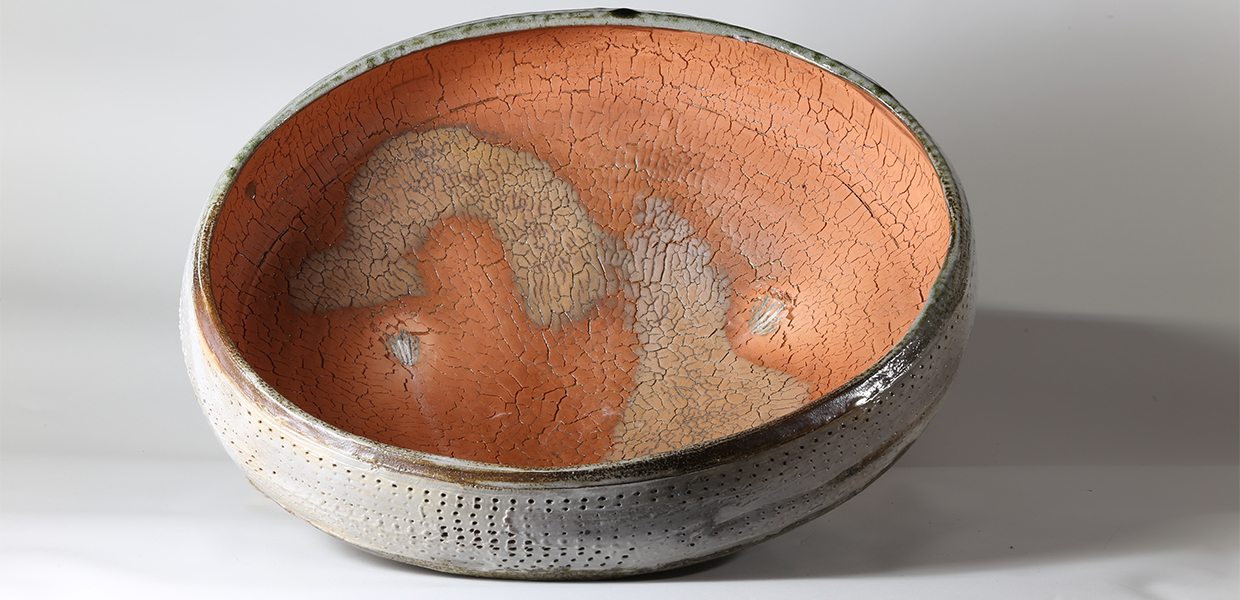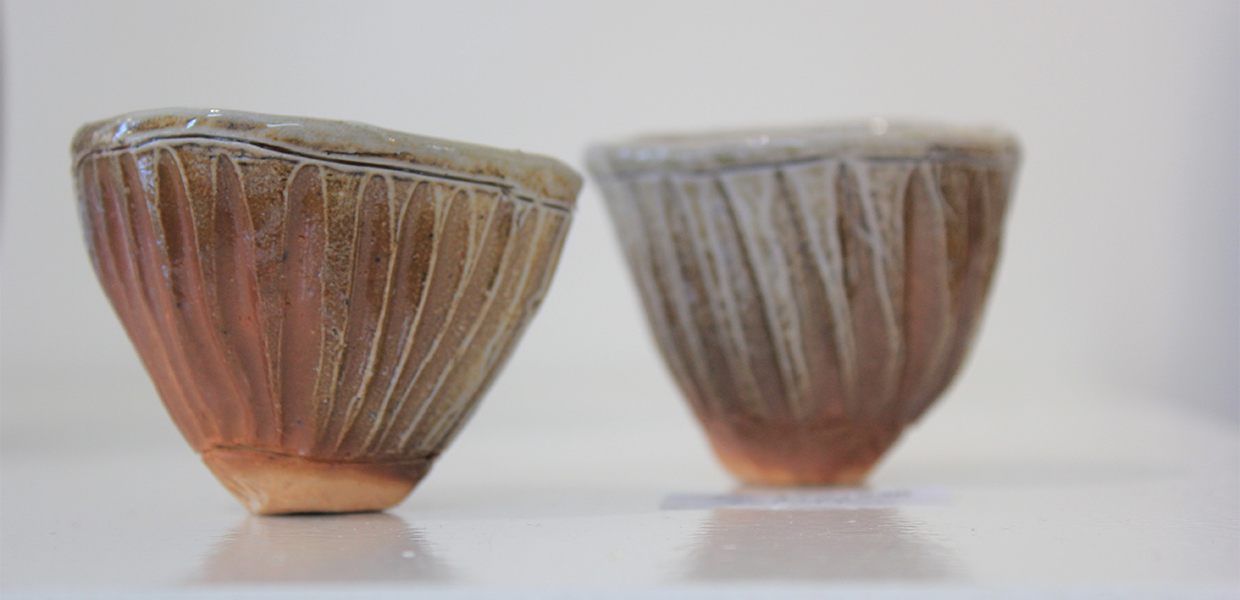Suvira McDonald
Could you give a brief description of your current practice and the number of years you have been involved in ceramics?
My arts practice has had a visual arts focus for 30 years now including the first 8 years of solid tertiary study at Lismore TAFE and Southern Cross University. The early years had a wood fired ceramic focus under the guidance of the various teachers at the time, namely the Terania Creek lineage: Kerry Sellwood, Malina and Dennis Monks and Tony Nankervis. Peter Estreich and John Stewart were also influential at the time. In the nineties Lismore was bastion of wood fired ceramics.
On being confronted with the reality of surviving as a ceramic artist I was unable to maintain wood firing as a focal point in my practice and quickly diversified, maintaining a level of production of tableware, various vessels, sculptural work and also a genre that I innovated which was wall-mounted landscapes; a form of relief sculpture presented on acrylic panels which gave the appearance of the work floating out from the wall. Additionally, I became more and more involved in the production and exhibition of sculpture in other media through various opportunities and developed skills in welding and working with wood.
In the last four years I have built a traditional anagama kiln and have resumed wood firing as the centre of my practice, producing a diverse range of work with sublime surface treatments.
When and why did you move to the Northern Rivers of NSW?
I was originally living in the NSW Northern Rivers in the early 70s seeking an alternate life style and, as a refugee from the corporate culture I had been educated for, I spent four years finding myself anew and uncovering what I realised was my creative force. I moved away in 1974, to urban centres for studies in dance and theatre which I pursued vigorously for 15 years with some fulfillment. In 1990 circumstances ushered me to the threshold of ceramics and I returned northwards in 1991 seeking a transition from theatre arts to visual arts. I was signed up to attend Lismore TAFE before I even arrived back in Byron Bay and this region, which I had recognised deep down as home. I have lived here continuously since then and on one property for the last 25 years!
What part(s) of the Northern Rivers have you worked in and can you tell us about the type of work you have delivered?
As a student at TAFE I spent my early days working in the studio there, fortunately the time restrictions on studio attendance were not too severe then and I had long hours making work and packing kilns. I was living in Byron Bay at the time and after a couple of years took up studio space in Byron Industrial Estate. That studio became Byron Artisans Collective Inc and received a grant to renovate the building – upgrading the studio, amenities and gallery space. That was a valuable experience and I did start teaching at what is now Byron Community College around that time.
Throughout this period I was involved in my own education and was producing wood fired work in the kilns at TAFE. I had also installed a gas kiln in my Byron studio and began tableware production, selling through the gallery. However, the admin and the politics of the collective became unmanageable and I decided to apply for the post graduate program at Southern Cross University. Studying under the supervision of Tony Nankervis instilled an academic rigour into my practice with an ongoing evaluative dimension to writing and production. The vessels and sculpture were informed by research into the available technologies of kiln, glaze and clay composition. The economics of producing work during this time became a secondary consideration to excellence. Also, at this time I built my studio at Goonengerry where I produced work and took it to the university for firing on the wood kiln I had built as part of my research. The vessels and sculpture were themed around death and dying – the research survey I was conducting after a close friend had recently died in a light plane accident. My graduate exhibition was entitled ‘Departing Spirits’ at Lismore Regional Gallery, in 1999.
At the completion of my post grad research I was cut loose and de-institutionalised. There were scarce tertiary teaching jobs as the institutions were being throttled by their respective administrations. I was living on a shoestring making tableware and some small sculpture and teaching introductory courses at Byron Community College. Thursday Plantation Sculpture Show was still active and my ceramic installations were a meaningful and important part of my annual production. The logistics and technical challenges of large-scale ceramics outdoors however, prompted me to diversify into metal sculpture early in this period.
From 2000 – 2014, a hiatus from wood firing, I developed my studio practice across multiple modalities including an innovative approach to wall-mounted ceramics with landscape imagery emerging from research into the Golden Age of landscape painting in Australia. This evolving work became topographical perspectives with rich textural surfaces. Over the same period, I produced “mountain’ sculptures, informed by an ancient Asian practice of rock collecting. Both these are threads I periodically revisit. I was also teaching at an introductory level as well as occasional potters’ workshops mixing production techniques of wheel forming, slab construction and firing kilns in reduction atmospheres of which I realised many people had little idea. During these years several international potters approached me to do mentorships (attracted by the Byron Bay address I suppose)). These were very successful times and foreshadowed the various mentorships currently happening in my workshop here today.
Over the years I have taught various workshops, some by invitation from potters’ groups in Queensland, at Gaia Retreat, in schools and some teaching at Southern Cross University in Lismore. The ongoing position as pottery tutor at Byron Regional College continued for nearly 20 years. Currently the courses I occasional hold are for Sculpture or Public Art.
All the various avenues of work seem to occasionally call me back whether it is by way of a commission or new inspiration – like multiple wheels all turning in their own cycles. I have had requests to produce major works and I currently have works situated in public places throughout the Northern Rivers and in private collections worldwide. A career peak was the commission from Elements of Byron Resort where I currently have installed a major work in stainless steel in the resort lobby and a mural 5m X 1.2 m installed behind a bar in the conference section. These were both works that extended me beyond anything I had previously undertaken and demonstrated to me the augmenting effect of a patron’s challenge.
In 2014 having slowly assembled the required bricks and prepared the site I started construction of the long awaited anagama, a traditional Japanese–style wood fired kiln. I have since fired it 11 times to date slowly eclipsing other parts of my practice. The work comprises utilitarian and large ritual vessels as well sculptural forms produced in slab constructions. Although I am currently standing up to the rigours of this approach to firing ceramic work, I can see a ‘USE BY’ date on my body.
Has living and working in a regional area defined your arts practice parameters? Have you considered your location restricting or motivating?
I am definitely inspired by living and working in a natural setting. However, I do realise and many friends have said to me over the years, that as a career move, city life would probably be very beneficial. As someone who soaks up my surrounds and translates that in to the work it would fundamentally change what I do and how I do it. Being a regional potter/artist is a lifestyle choice I made long ago. So – it is both restricting and motivating.
Has your practice undertaken major changes/challenges in your more mature years?
There is no question about the bodily limitations of aging. I make less work than I did but it is generally more resolved and I am happier with both the quality of the work and that there is less of it. In addressing the physicality of a ceramics practice I have reached out for help and have assistance in the studio, I also provide opportunities for some early career artists to learn by osmosis in my studio and help out with some of the work. I have created a learning environment, especially around the wood firings and no longer teach in a class room set up. The next generation bring with them superior e-skills which I appreciate.
Probably soon, with my partner, I will be downsizing home and studio which will bring about an entirely new configuration, I hope there is a good few years of wood firing in me yet. While there is help in that respect there is hope!!
How have you maintained your passion for your practice over the years?
My interest in the work is sustained by the results I get. Those results are the work itself, the economic results and the social and professional exchange that follows. It is an evolving process full of discoveries and exchanges that fascinate, disappoint and challenge.
Do you use social media platforms as a useful resource for your work as an artist?
I do believe social media has a powerful part to play in promotion of my art and I use it. My young assistant is currently working Instagram and I personally handle the Facebook posts. I have had very little direct financial results but the indirect result from a profile enhancement is something I am aware of even if it is not measurable in any accurate way. Social media has definitely led to international connections and online exposure to a diversity of work by other artists.
Are you concerned about sharing your skills and knowledge with the next generation of artists in your field?
I am somewhat concerned with that and for that reason I have produced a learning environment around my kiln. I have young and returning potters who find their way here to discover the magic of wood firing and the community dimension of that. Wood firing is a team effort and in this environment people who may not otherwise find themselves together come to prepare wood, prepare the kiln and talk about their work and fire it. The firings are over three days so it is a unique commitment.
How do you see the future development of your arts practice?
I was a late starter with ceramics and even at my age I feel I may be reaching mid-career status only now. I diversified into other sculptural media in the last 20 years but now ceramics is becoming more important, so it feels as though the scale of works may start to reduce. Certainly, more of the same and hopefully more far reaching exhibitions. I have never travelled a great deal with my work because the homestead has required my ongoing presence. That might change.
Any other comments you would like to make?
I do not have a retirement plan.








